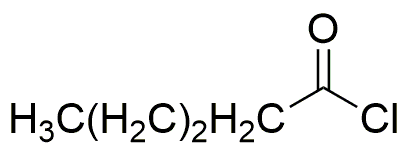Valeryl chloride is widely utilized in research focused on:
- Synthesis of Pharmaceuticals: It serves as an important intermediate in the production of various pharmaceutical compounds, enhancing the efficiency of drug development processes.
- Organic Synthesis: Valeryl chloride is used in organic chemistry for the synthesis of esters and amides, which are essential in creating diverse chemical products.
- Polymer Production: This compound plays a role in the manufacture of specialty polymers, contributing to materials with unique properties for applications in coatings and adhesives.
- Flavor and Fragrance Industry: It is employed in the synthesis of flavoring agents and fragrances, providing a means to create appealing scents and tastes in food and cosmetic products.
- Laboratory Reagents: Valeryl chloride is utilized as a reagent in various laboratory procedures, offering researchers a reliable option for chemical reactions requiring acyl chlorides.
General Information
Properties
Safety and Regulations
Applications
Valeryl chloride is widely utilized in research focused on:
- Synthesis of Pharmaceuticals: It serves as an important intermediate in the production of various pharmaceutical compounds, enhancing the efficiency of drug development processes.
- Organic Synthesis: Valeryl chloride is used in organic chemistry for the synthesis of esters and amides, which are essential in creating diverse chemical products.
- Polymer Production: This compound plays a role in the manufacture of specialty polymers, contributing to materials with unique properties for applications in coatings and adhesives.
- Flavor and Fragrance Industry: It is employed in the synthesis of flavoring agents and fragrances, providing a means to create appealing scents and tastes in food and cosmetic products.
- Laboratory Reagents: Valeryl chloride is utilized as a reagent in various laboratory procedures, offering researchers a reliable option for chemical reactions requiring acyl chlorides.
Documents
Safety Data Sheets (SDS)
The SDS provides comprehensive safety information on handling, storage, and disposal of the product.
Product Specification (PS)
The PS provides a comprehensive breakdown of the product’s properties, including chemical composition, physical state, purity, and storage requirements. It also details acceptable quality ranges and the product's intended applications.
Certificates of Analysis (COA)
Search for Certificates of Analysis (COA) by entering the products Lot Number. Lot and Batch Numbers can be found on a product’s label following the words ‘Lot’ or ‘Batch’.
*Catalog Number
*Lot Number
Certificates Of Origin (COO)
This COO confirms the country where the product was manufactured, and also details the materials and components used in it and whether it is derived from natural, synthetic, or other specific sources. This certificate may be required for customs, trade, and regulatory compliance.
*Catalog Number
*Lot Number
Safety Data Sheets (SDS)
The SDS provides comprehensive safety information on handling, storage, and disposal of the product.
DownloadProduct Specification (PS)
The PS provides a comprehensive breakdown of the product’s properties, including chemical composition, physical state, purity, and storage requirements. It also details acceptable quality ranges and the product's intended applications.
DownloadCertificates of Analysis (COA)
Search for Certificates of Analysis (COA) by entering the products Lot Number. Lot and Batch Numbers can be found on a product’s label following the words ‘Lot’ or ‘Batch’.
*Catalog Number
*Lot Number
Certificates Of Origin (COO)
This COO confirms the country where the product was manufactured, and also details the materials and components used in it and whether it is derived from natural, synthetic, or other specific sources. This certificate may be required for customs, trade, and regulatory compliance.

